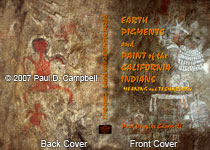 |
 |
 |
 |
 |
 |
 |
 |
 |
PICTOGRAPHS PETROGLYPHS YONIS
KUMEYAAY PICTOGRAPHS PETROGLYPHS cave rock art paintings drawings, Native American tribal symbols, patterns, designs, ancient Diegueno Kumeyaay grinding stones and Kumeyaay Yoni rock sculptures paint pigments at Indian Hill, Anza Borrego, California, 19NOV04.
This remote desert area is a well known Kumeyaay site for Late Prehistoric Period Native American cave art, rock carvings and ancient artifacts relics.
Late Prehistoric Period
Archaeological evidence from major excavations in the 1950s virtually proves this area has been inhabited by California Indians for at least 6000 years, since 4000 B.C. The Northern Diegueño and Kumeyaay peoples are believed to be its most recent inhabitants.
At the trurn of the 21st Century, this area is known as Indian Hill and it is located in remote San Diego County wildnerness backcountry, Anza Borrego Desert State Park.
The experts estimate the surviving cave drawings pictured above are less than a couple hundred years old. The cave, known as the Blue Sun Cave for its blue sunburst pictograph, has two different styles of pictographs which suggests use by two different cultural groups.
Caption SOURCE (and more detailed information) WEBSITE © 2004 petroglyphs.us:
La Rumorosa Style:
Characterized by polychrome rectangular and curvilinear designs in red, black, yellow, and white. Sunbursts, divided circles and amorphic shapes, bold lines, and simple 'stickman' anthropomorphs are common; two or more colors are often used in one element. This style is associated with the Kumeyaay people post AD 1500, occurs on both sides of the U.S.-Mexico border, and is named by Ken Hedges for the extensive La Rumorosa Pictograph Site in Baja, Mexico.
San Luis Rey Style:
Characterized by rectangular geometric designs in red which include diamonds, diamond chains, zigzags, chevrons, straight lines and dot patterns; often in vertical series; frequently bordered at top and/or bottom; rare representational and curvilinear elements (True, 1954). Associated with late prehistoric and historic Luiseno people. Type site is on the San Luis Rey River, San Diego County, California.

INDIGENOUS CALIFORNIA INDIAN WEAPONRY, war clubs including ethnographic tribal art and designs.
 REVIEW THIS BOOK (Buy Now Link AMAZON.COM)
REVIEW THIS BOOK (Buy Now Link AMAZON.COM)
The pictures and writing in this section are parts of Paul Campbell's newest book, EARTH PIGMENTS AND PAINT: MEANING AND TECHNOLOGY. His fully-researched book will include all facets of Native California pigments and paint, including physical, social, spiritual — in great detail — and will reveal how the Indians turned yellow pigment red, and about how they made blue from white gypsum and black charcoal, and it will give many other recipes for Indian paint. The book will also discuss the origin of CAVE ART in California, and the latest atomic accelerator testing of the ancient pigments used by the California Indians.
Kumeyaay Indians Home • About Us • Mission Statement • Press Kit • Contact Us